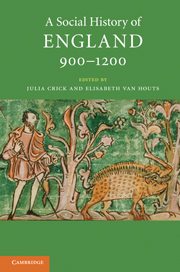Book contents
- Frontmatter
- Contents
- List of figures
- List of maps and tables
- List of contributors
- Acknowledgements
- List of abbreviations
- Map 1 England and its neighbours
- Map 2 England 900–1200
- I Introduction
- I.1 Land use and people
- I.2 Water and land
- I.3 Forest and upland
- I.4 Mineral resources
- I.5 Health and disease
- II.1 Authority and community
- II.2 Lordship and labour
- II.3 Order and justice
- II.4 War and violence
- II.5 Family, marriage, kinship
- II.6 Poor and powerless
- III.1 Towns and their hinterlands
- III.2 Commerce and markets
- III.3 Urban planning
- III.4 Urban populations and associations
- IV.1 Invasion and migration
- IV.2 Ethnicity and acculturation
- IV.3 Intermarriage
- IV.4 The Jews
- V.1 Religion and belief
- V.2 Rites of passage and pastoral care
- V.3 Saints and cults
- V.4 Public spectacle
- V.5 Textual communities (Latin)
- V.6 Textual communities (vernacular)
- VI.1 Learning and training
- VI.2 Information and its retrieval
- VI.3 Esoteric knowledge
- VI.4 Medical practice and theory
- VI.5 Subversion
- Glossary
- Time line 900–1200
- Further reading
- Index
I.4 - Mineral resources
Published online by Cambridge University Press: 05 June 2012
- Frontmatter
- Contents
- List of figures
- List of maps and tables
- List of contributors
- Acknowledgements
- List of abbreviations
- Map 1 England and its neighbours
- Map 2 England 900–1200
- I Introduction
- I.1 Land use and people
- I.2 Water and land
- I.3 Forest and upland
- I.4 Mineral resources
- I.5 Health and disease
- II.1 Authority and community
- II.2 Lordship and labour
- II.3 Order and justice
- II.4 War and violence
- II.5 Family, marriage, kinship
- II.6 Poor and powerless
- III.1 Towns and their hinterlands
- III.2 Commerce and markets
- III.3 Urban planning
- III.4 Urban populations and associations
- IV.1 Invasion and migration
- IV.2 Ethnicity and acculturation
- IV.3 Intermarriage
- IV.4 The Jews
- V.1 Religion and belief
- V.2 Rites of passage and pastoral care
- V.3 Saints and cults
- V.4 Public spectacle
- V.5 Textual communities (Latin)
- V.6 Textual communities (vernacular)
- VI.1 Learning and training
- VI.2 Information and its retrieval
- VI.3 Esoteric knowledge
- VI.4 Medical practice and theory
- VI.5 Subversion
- Glossary
- Time line 900–1200
- Further reading
- Index
Summary
Britain has long enjoyed a reputation for its mineral wealth. Bede, writing in the early eighth century, noted that it had ‘many veins of metals, as copper, iron, lead and silver’. Henry of Huntingdon, in about 1130, added tin to that list but commented that silver was uncommon, being ‘received from the neighbouring parts of Germany with which an extensive commerce is carried out by the Rhine’.
Much of the evidence for the demand and production of minerals in the period to 1200 comes from the increased generation and survival of documentary sources, in particular, during the latter part of the period, the records of English government (see Chapter VI.2). The archaeological record is at best fragmentary, and few overviews of any value have yet been published. There is, however, sufficient evidence to indicate that production increased substantially in the three centuries covered by this volume. Although metals had particular social and economic significance, other mineral resources were of equal, if not greater, practical importance. Salt was an essential of life at a period and in a climate which allowed for no other means of preserving food over the winter, ensuring a continuity of production. It was one of the resources considered here, along with limestone and chalk burned for mortar, which were totally consumed without prospect of being reused or recycled. In contrast, the ability to reuse some materials might mean that quarrying or mining was delayed until other sources were exhausted.
- Type
- Chapter
- Information
- A Social History of England, 900–1200 , pp. 56 - 65Publisher: Cambridge University PressPrint publication year: 2011
- 1
- Cited by



